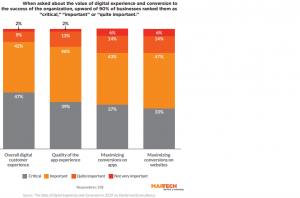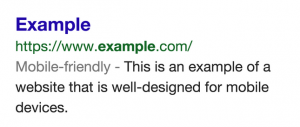If we’ve learned anything in 2020, it’s that flexibility is key to being a strong product manager – especially when it comes to the mobile experience. Customer behaviors and preferences are shifting daily – as are their emotions.
For many mobile product managers, their biggest goal is to create a realistic product roadmap and hit key milestones on time. But for the most advanced mobile PMs, success goes beyond just checking boxes. Success is understanding how the product fares in the market, and being able to adjust properly, pivot, and quickly make decisions based off of customer feedback.
Here are some of the best pieces of advice we’ve heard for mobile product managers over the years that are especially important in today’s mobile-first environment (as told by Schitt’s Creek GIFs because, why not?).
Make mistakes and adapt quickly
As a successful mobile product manager, you must be willing and open to being wrong. It is not whether you make mistakes (spoiler alert, you will), but how you learn from them that matters.
Learning how to pivot quickly and adjust roadmaps is one of the most important skills a mobile PM can have.
You don’t need a technical degree to be a strong PM
The product management profession requires varying degrees of technical skill, but it’s not one-size-fits-all and certainly does not require an engineering-based degree. We wanted to know how technical the average product manager is, how PMs define “technical,” and where they go for continued education.
We recently conducted a survey of 100 product managers, and eight percent of our respondents don’t consider themselves technical at all (i.e. do not interface with developers in a technical way). Over half of respondents (65 percent) considered themselves mildly technical (i.e. ability to read code, write some HTML/CSS, and troubleshoot computer issues), but are not completely proficient. The technical skills our respondents possess increased from there, with 25 percent of respondents reporting strong technical skills (i.e. ability to write and read code), and two percent identifying as self-proclaimed “technical geniuses” (i.e. likely starting as an engineer and moving into mobile product management).
Go beyond NPS as a core KPI
Net Promoter Score, or NPS, has become the industry standard for gauging customer loyalty. Introduced in the Harvard Business Review in 2003, NPS is still appealing because it provides one consistent scale to measure customer sentiment over time. However, aside from acting as a badge of honor (and sometimes a point of shame), an NPS score alone doesn’t actually do anything and is an outdated way of measuring customer loyalty and predicting retention. At the end of the day, companies are left with no guidance or insight as to what needs to be done to improve an NPS score—and ultimately, what needs to be done to grow actual business and customer loyalty. When the “why” behind the data doesn’t exist, it’s impossible to make strategic decisions.NPS is the best measure of customer loyalty.
We understand the need to leverage an NPS-like tactic, which is why we came up with a better way to gauge customer loyalty: NPS+. By simply asking customers, “Why did you choose this score?” after the traditional rating question and allowing customers to provide unstructured feedback, we help companies contextualize the NPS score and understand where their customers think the company is doing well and where they need to improve. This makes the survey valuable and relevant for the end customer.
Don’t blindly build what your customers ask for
Feedback is key, but you will be running in circles if you only follow customer recommendations to build your product roadmap. People often prescribe what they think they want, but there’s often a better solution that actually solves the underlying problem. As Henry Ford stated long ago, “If I’d asked customers what they wanted, they would have told me, ‘A faster horse!’” To get to the root of what changes are necessary, product managers need to dive deeper into understanding customers pain points as well as what gives them value. This means listening deeply to customer feedback and sentiment, and asking the right questions at the right places and times within your digital experience.
Customers leave helpful feedback because they want to be a part of the process. Today’s consumers have a desire to provide helpful insight for the brands they interact with, especially through mobile channels. However, companies undervalue asking their customers for feedback across touchpoints or are scared to “open up the floodgates” of feedback when they might not know how to handle it, which is problematic.
Customer feedback is incredibly valuable, but product managers must understand why people feel the way they do before acting on their feedback. By not making it a priority to ask for, listen to, and implement customer feedback in a constructive manner, companies are missing a huge opportunity to closely align their business with their customers’ wants, needs, and expectations—while still keeping their product roadmap aligned with business goals. Tools like Apptentive are here to help make the process easier. Additionally, although you can’t give everyone everything they want, you can always show up and listen to their needs in order to prioritize the things you do have time to deliver. Take time to really listen to pain points and blockers to understand how you can be the most effective and efficient. The deeper you understand where information gaps exist, the clearer the solution to bridging them will look, and the faster you can get it done.
Don’t make decisions in a silo
Product managers should be facilitators, but you should not make the final call on what is built. Instead, you should conduct customer research, ask great questions, and facilitate all aspects of the internal decision-making process across teams. As a product leader, your goal is to constantly provide a better product to deepen engagement, grow your revenue, and delight your customers. In order to do so, you need to listen—we mean really listen—to customer feedback. Far too often, companies don’t take action based on the feedback their customers provide, and instead make major product decisions in a vacuum. A lack of communication and implementation of customer feedback can affect brand loyalty and customers’ willingness to provide feedback in the future.
“PMs sit at this intersection of design, business, and technology or engineering….A PM’s job often is to help, not necessarily have the idea themselves but sort of, like, create the environment for those ideas to come up organically.” – Priya Dandawate, PM at Stripe
Gather feedback from more customers
Because many brands struggle to gather customer feedback in proactive, non-intrusive ways, feedback typically comes from the smallest, most vocal group of customers. Many brands today may think they build products around their customers based on feedback from a majority, but they couldn’t be further from the truth. In reality, Apptentive’s data shows that brands only hear from less than one percent of their customer base, which we call the “vocal minority.”
The vocal minority is made of up of two groups of customers: those who are at risk and those who are fans. The at-risk customers have typically had a negative experience with your brand that triggered their feedback—their meal was bad, their flight was delayed, or they ran into an irritating bug in your app. They’ve raised their proverbial hands to alert you of their problem, whether it’s a one-off occurrence or affecting a larger group of your customers. The fan group’s experience is just the opposite. These are your all-star, loyal customers—the ones who engage in every email, refer you to their friends, interact with you through other digital channels, and purchase your goods and/or services regularly.
There is much to learn from the vocal minority of at-risk customers and fans. The vocal minority has a lot to say, and product professionals and marketers must listen to the group’s feedback and respond to it accordingly. But remember, the vocal minority makes up roughly one percent of the average brand’s customer base.
The most dangerous decision a brand can make is acting on feedback that doesn’t accurately represent the majority of its customers.
Proactively engage with customers rather than reactively
Our research shows 51 percent of consumers expect companies to ask for their feedback across all channels (email, phone, in-store, online, etc.), and that number is even higher for consumers who prefer to leave in-app feedback (64 percent). What’s even better is that app customers are very willing to give feedback: 98 percent of our respondents said they will likely give feedback when asked.If you proactively engage customers, you’ll scare them away.
The key is to be proactive in asking for their feedback rather than waiting for them to raise their hands, and to ask at the right moment within your digital experience in order to give conversations the best opportunity to begin. If you’re not proactively asking for feedback, you’re leaving an opportunity on the table to keep your finger on the pulse of your app customers, improve customer happiness, and boost your bottom line. There is endless untapped potential in prioritizing customer feedback from your silent majority, but you must be strategic in your approach to collect it.
Through proactive engagement and creating customer feedback loops, Apptentive has helped our customers boost engagement to 23 percent, reaching over 20 times more consumers than the conventional rate. In turn, our customers are able to be more dollar efficient, prioritize product planning better, and expand their loyal segment of customers through listening and responding.
Build for mobile app and web users differently
Customer paths look different for all interfaces (mobile app, mobile web, desktop web, etc.). When you think about building a product that can be accessed through multiple interfaces, it’s crucial to keep usability at the forefront of every feature decision. You can build the best product in the world, but if it’s hard to access across interfaces, its greatness means nothing. To start, screen size across various interfaces is a key usability factor. Larger screen sizes give you the ability to add more stuff, and small screen sizes mean you must cut down and conserve space wherever you can. Interaction is also a major influence. On desktop, customers typically interact with cursors, and on mobile devices, interaction occurs through gestures. The ways the human brain parses these actions varies dramatically between interfaces.
The way content is organized also plays a dramatic role in how a product will be used across interfaces (scrolling vs. columns, portrait vs. landscape, etc.), as well as usage. People still use desktop devices for larger, more involved tasks, where mobile functionality tends to be more experimental and quick. The big takeaway here is that people approach products completely differently depending on the interface, and it’s crucial to consider all use cases separately before a product roadmap for each interface is in place.
Being a mobile product manager is no small task. You shoulder a hefty portion of the responsibility for creating a successful mobile application. Remember, success looks different to everyone, but it should be based off of the goals you set in the beginning stages of formulating the product.
Business & Finance Articles on Business 2 Community
(54)
Report Post





